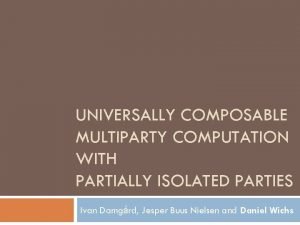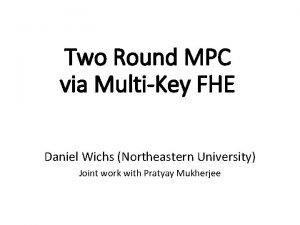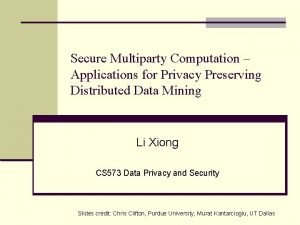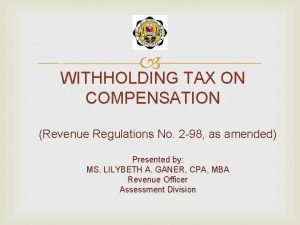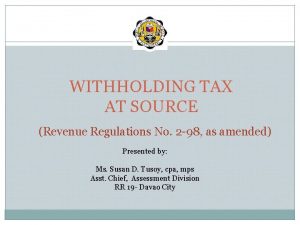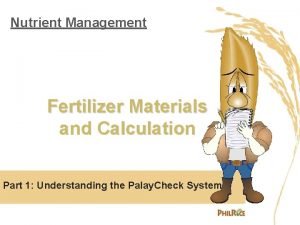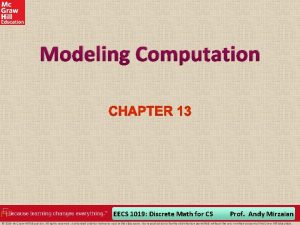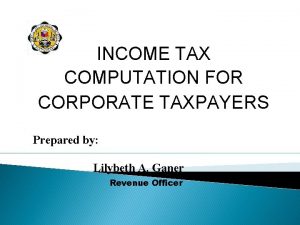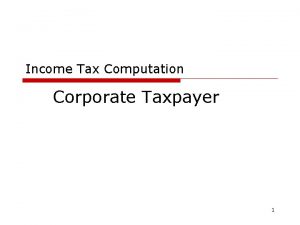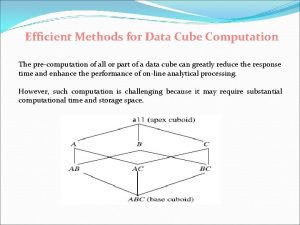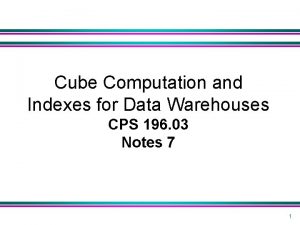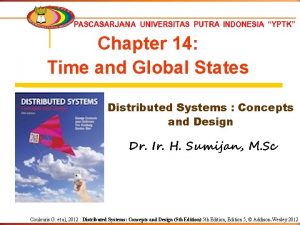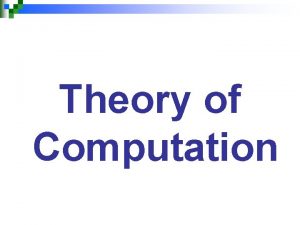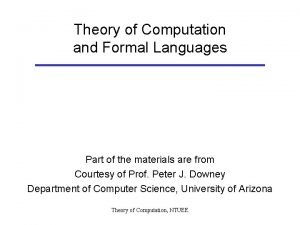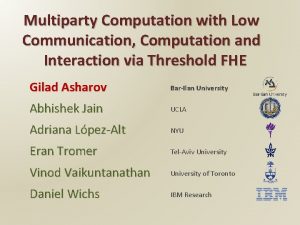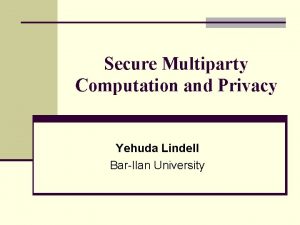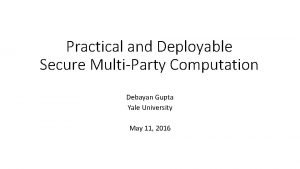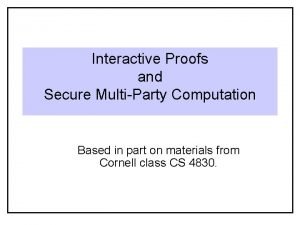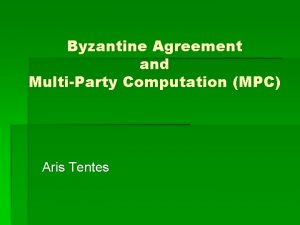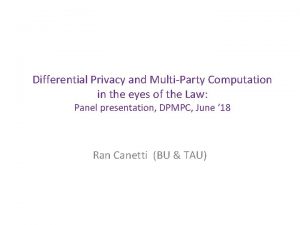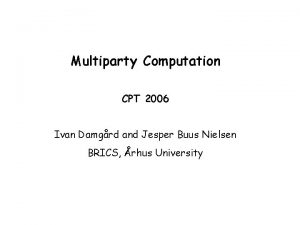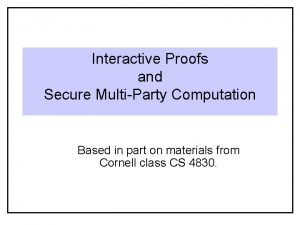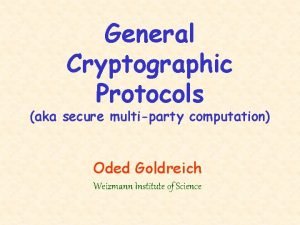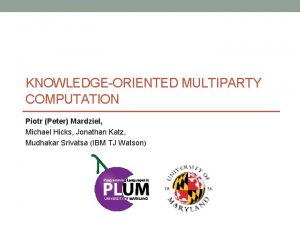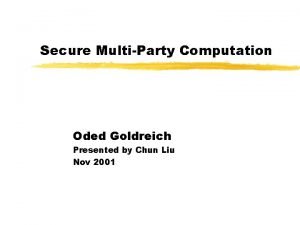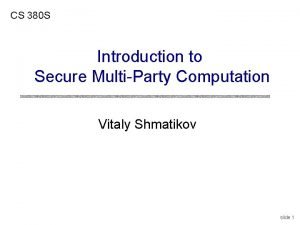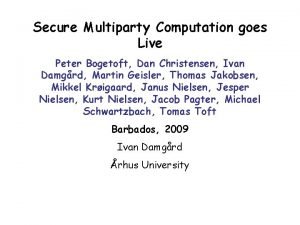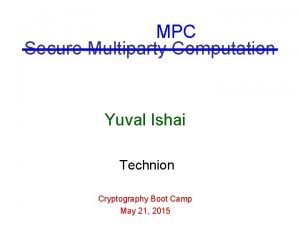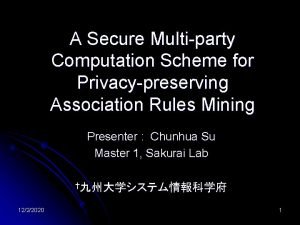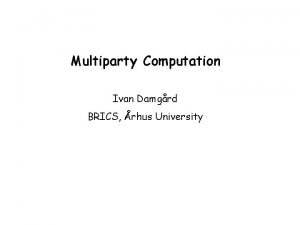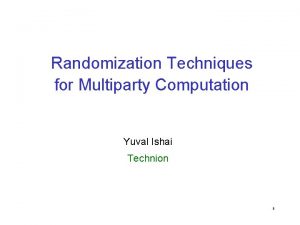Multiparty Computation with Low Communication Computation and Interaction














![Related Work [Cramer. Damgard. Nielsen 01]– MPC using threshold HE [Gentry 09] – MPC Related Work [Cramer. Damgard. Nielsen 01]– MPC using threshold HE [Gentry 09] – MPC](https://slidetodoc.com/presentation_image_h/f933cf747e1028bd6b7547b472e41e38/image-15.jpg)
![The LWE Assumption [Regev 05] • Distribution 1 • Distribution 2 also secure if The LWE Assumption [Regev 05] • Distribution 1 • Distribution 2 also secure if](https://slidetodoc.com/presentation_image_h/f933cf747e1028bd6b7547b472e41e38/image-16.jpg)









![FHE From LWE [BV 11 b], [BGV 12] • S ! d e i FHE From LWE [BV 11 b], [BGV 12] • S ! d e i](https://slidetodoc.com/presentation_image_h/f933cf747e1028bd6b7547b472e41e38/image-26.jpg)









- Slides: 35

Multiparty Computation with Low Communication, Computation and Interaction via Threshold FHE Gilad Asharov Bar-Ilan University Abhishek Jain UCLA Adriana López-Alt NYU Eran Tromer Tel-Aviv University Vinod Vaikuntanathan University of Toronto Daniel Wichs IBM Research

2 -Party Computation Using FHE (semi-honest) a b y = f(a, b) A=Encrypt(a) Y Charlie y Y=Eval(f, A, B) Sally

Advantages Low round complexity Low communication complexity • Independent of the function f Can we get allofthese advantages • Independent Sally’s input b Lowin computation the multiparty case? • Charlie’s work is independent of f A simple template

Threshold Key Generation

Threshold Key Generation

Input Encryption a b A=Enc(a) C=Enc(c) c B=Enc(b) A B C D D=Enc(d) d

Homomorphic Evaluation A B C D Homomorphic Evaluation Y Y Homomorphic Evaluation A B C D

Delegate to a Cloud A B C D Homomorphic Evaluation Y

Threshold Decryption Y Y Dec Y Y

Threshold Decryption m m Dec m m

MPC with Threshold FHE • Threshold Key Gen • Encrypt and Evaluate • Threshold Decryption

MPC with TFHE • Threshold Key Gen • Encrypt and Evaluate • Threshold Decryption • Threshold Key. Gen and Threshold Dec can be implemented using generic MPC • Advantages: Low communication complexity (even in malicious) The homomorphic evaluation can be delegated / only one party • Disadvantages: Needs generic MPC techniques Round complexity can be high

Our Main Results • Threshold Key Gen • Encrypt and Evaluate • Threshold Decryption • Threshold Key. Gen and Threshold Dec algebraically [BV 11 b, BGV 12] (based on LWE) • Advantages: Low communication complexity (even in malicious) The homomorphic evaluation can be delegated / only one party Simple: there is no need for generic MPC protocol Extremely low round complexity Only 3 broadcast rounds (CRS model) 2 rounds reusable PKI – optimal(!)

Our Main Results (malicious) • Threshold Key Gen • Encrypt and Evaluate • Threshold Decryption • Threshold Key. Gen and Threshold Dec algebraically [BV 11 b, BGV 12] (based on LWE) • Advantages: Low communication complexity (even in malicious) The homomorphic evaluation can be delegated / only one party (assuming cs poofs / SNARGs) Simple: there is no need for generic MPC protocol Extremely low round complexity Only 3 broadcast rounds (CRS model) 2 rounds reusable PKI – optimal(!) UC security (assuming UC-NIZK)
![Related Work Cramer Damgard Nielsen 01 MPC using threshold HE Gentry 09 MPC Related Work [Cramer. Damgard. Nielsen 01]– MPC using threshold HE [Gentry 09] – MPC](https://slidetodoc.com/presentation_image_h/f933cf747e1028bd6b7547b472e41e38/image-15.jpg)
Related Work [Cramer. Damgard. Nielsen 01]– MPC using threshold HE [Gentry 09] – MPC using threshold FHE [Bendlin. Damgard 10] – threshold version for LWE [Katz. Ostrovsky 04] – lower bound of 5 rounds for MPC in the plain model • [Myers. Sergishelat 11] – threshold version of [v. DGHV 10] • •
![The LWE Assumption Regev 05 Distribution 1 Distribution 2 also secure if The LWE Assumption [Regev 05] • Distribution 1 • Distribution 2 also secure if](https://slidetodoc.com/presentation_image_h/f933cf747e1028bd6b7547b472e41e38/image-16.jpg)
The LWE Assumption [Regev 05] • Distribution 1 • Distribution 2 also secure if q is odd and we choose noise to be small and even (2 e instead e)

Basic LWE-Based Encryption • Symmetric Key • Public Key

Key-Homomorphic Properties of the Basic Scheme Two public keys, same “coefficient” A A new public key with secret key: s 1+s 2, coefficient A (almost the same as El-Gammal)

Threshold Key Generation A s 1 s 2 (A, p 1) = As 1+2 e 1 (A, p 2) = As 2+2 e 2 (A, p 3) = As 3+2 e 3 (A, p 4) = As 4+2 e 4 s 3 s 4

Threshold Key Generation A s 1 s 2 (A, p 1) = As 1+2 e 1 (A, p 2) = As 2+2 e 2 (A, p 3) = As 3+2 e 3 (A, p 4) = As 4+2 e 4 s 3 s 4

Threshold Key Generation A s 1 (A, p 1) = As 1+2 e 1 s 2 (A, p 2) = As 2+2 e 2 (A, p*) (A, p 3) = As 3+2 e 3 (A, p*) = As*+2 e* (A, p*) (A, p 4) = As 4+2 e 4 s 3 Joint secret key: s*=s 1+s 2+s 3+s 4 Joint public key: p*=p 1+p 2+p 3+p 4 (A, p*) s 4

Threshold Decryption s 1 s 2 s 3 s 4

Threshold Decryption s 1 s 2 s 3 s 4

Threshold Decryption s 1 s 2 s 3 s 4

Basic LWE-Based Encryption – Homomorphism •
![FHE From LWE BV 11 b BGV 12 S d e i FHE From LWE [BV 11 b], [BGV 12] • S ! d e i](https://slidetodoc.com/presentation_image_h/f933cf747e1028bd6b7547b472e41e38/image-26.jpg)
FHE From LWE [BV 11 b], [BGV 12] • S ! d e i f i l p im

Evaluation Key •

Threshold Key. Gen –Round 2 s 1 s 2 … … … s 3 s 4

Threshold Key. Gen – End Of Round 2 s 1 s 3 … … s 2 s 4

Threshold Key. Gen – Round 3 s 1 … … … s 2 … … s 3 … s 4

Threshold Key. Gen – End Of Round 3 s 1 s 2 s 3 s 4

Threshold FHE - Key. Gen • one round!

The MPC Protocol • Threshold Key. Gen (2 rounds) – Round 1: Creates public key – Round 2: Creates evaluation key • The parties encrypt their inputs (sent concurrently with round 2 of Key. Gen) • Threshold Dec (1 round)

Malicious •

Conclusion • TFHE based on LWE – In the paper: Ring – LWE • 3 Rounds MPC • 2 Rounds in reusable PKI - optimal(!) • Low Communication Complexity • Easy to delegate Thank You!
 Multiparty computation
Multiparty computation Two round multiparty computation via multi-key fhe
Two round multiparty computation via multi-key fhe Compute
Compute Communication style bias
Communication style bias Mid = (low + high) / 2
Mid = (low + high) / 2 Significant figures
Significant figures Low voltage = low hazard
Low voltage = low hazard Communication in group dynamics
Communication in group dynamics Function of group dynamics
Function of group dynamics Low tech assistive technology for communication
Low tech assistive technology for communication What is oral communication and written communication
What is oral communication and written communication What is oral communication and written communication
What is oral communication and written communication Parallel and serial communication
Parallel and serial communication Who is not subject to withholding tax on compensation
Who is not subject to withholding tax on compensation Expanded withholding tax computation
Expanded withholding tax computation Expanded withholding tax computation
Expanded withholding tax computation Bir form 1901 job order
Bir form 1901 job order Fertilizer computation examples
Fertilizer computation examples Eecs 1019
Eecs 1019 Union set operation
Union set operation Individual tax computation format
Individual tax computation format Income tax computation format
Income tax computation format Pediatric dehydration fluid replacement formula
Pediatric dehydration fluid replacement formula Income tax computation format
Income tax computation format Data cube computation
Data cube computation Drug calculation formula
Drug calculation formula Data cube computation
Data cube computation Data cube computation
Data cube computation Iv fluid calculation formula
Iv fluid calculation formula Cuts of a distributed computation
Cuts of a distributed computation 2160704
2160704 Expanded withholding tax revenue regulation
Expanded withholding tax revenue regulation Net maintainable rent
Net maintainable rent Board feet computation
Board feet computation Graph transition
Graph transition Types of languages in theory of computation
Types of languages in theory of computation
